Celebrations are usually times when people get together with friends and family for drinks, food, and a few laughs. Maybe things get a little bit rowdy. But hopefully, nobody dies. That can’t be said for some festivities that are so outrageous they’re life threatening.
Ever think of riding a tree down a steep mountain or getting into a community-wide rock slinging fight? Or maybe you just want to celebrate Christmas by beating the crap out of that one family member you can’t stand. How about hitting your friends in the head with a bamboo sticks? And forget running with the bull. Do you want to chase one and wrestle it to the ground instead?
All are celebrations that happen once a year in some parts of the world that would make your craziest festival story seem like an elementary-school dance party.
So crack open a cold one and sit back in the comfort of your own home. You’re about to go on an exhilarating tour of the most extreme celebrations throughout the world.
Our first stop, Spain.
15. The Entroido Festival
The Entroido Festival is celebrated in the Spanish town of Laza to commemorate the beginning of Spring. The party lasts five days and it’s characterized by general mayhem. People run through the streets hitting each other with dirt, muddy rags, flour. And, oh yeah, bags of fire ants.
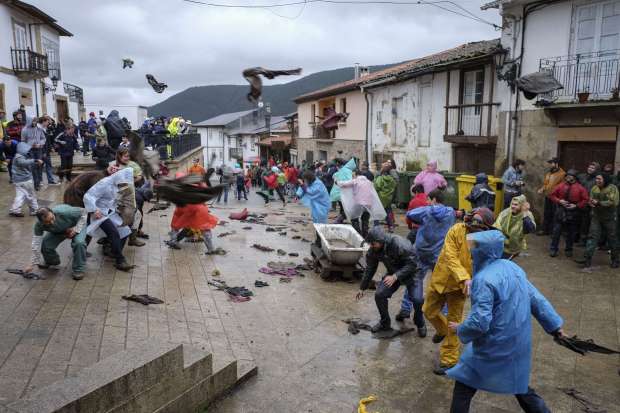
[adinserter block=”3″]
[adinserter block=”8″]
On the Monday of the festival, people gather for a huge mud fight. Meanwhile, other villagers head over to the mountains to pick up fistfuls of fire ants and throw them into dirt bags. They then add vinegar into the sacks to rally up the fire ants. Afterward, they descend back to the town to throw the bags of fire ants at the villagers.
But wait, there’s more. In the middle of the mud swinging fire-ant fight, a partyer wearing a wooden cow mask runs around butting people and lifting women’s skirts.
So, yea. How “crazy” was your sping break again?

[adinserter block=”7″]
[adinserter block=”2″]
14. The Baby Jumping Festival
Baptisms with holy water are overrated.
The daring babies in the Spanish village of Castrillo de Murica undergo a more extreme ritual. They’re placed on mattresses in rows of up to ten in the middle of the street. Then, men dressed as the devil leap over them. Locals believe the demons pull original sin from infants as they leap over them.
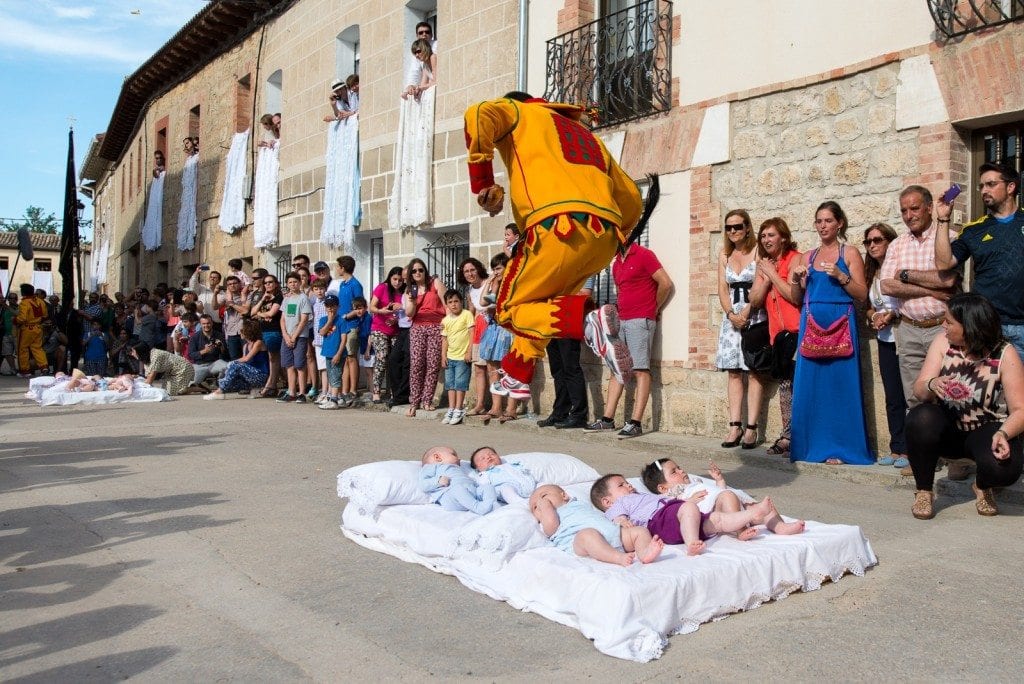
“EL Colacho,” or the Baby Jumping Festival, is usually held every year on the Sunday after Corpus Christi. Every year, babies born in the last twelve months are offered to the jump-suit wearing devils. The jumpers are members of the brotherhood known as Santisimo Sacramento de Minerva.
According to reports, there have been no serious injuries inflicted on the babies since the ritual was first held back in the 1600s.
Celebrations usually kick off a week before “El Colacho” with music processions and feasts. Oh, and the devil chases crowds through the streets with whips.
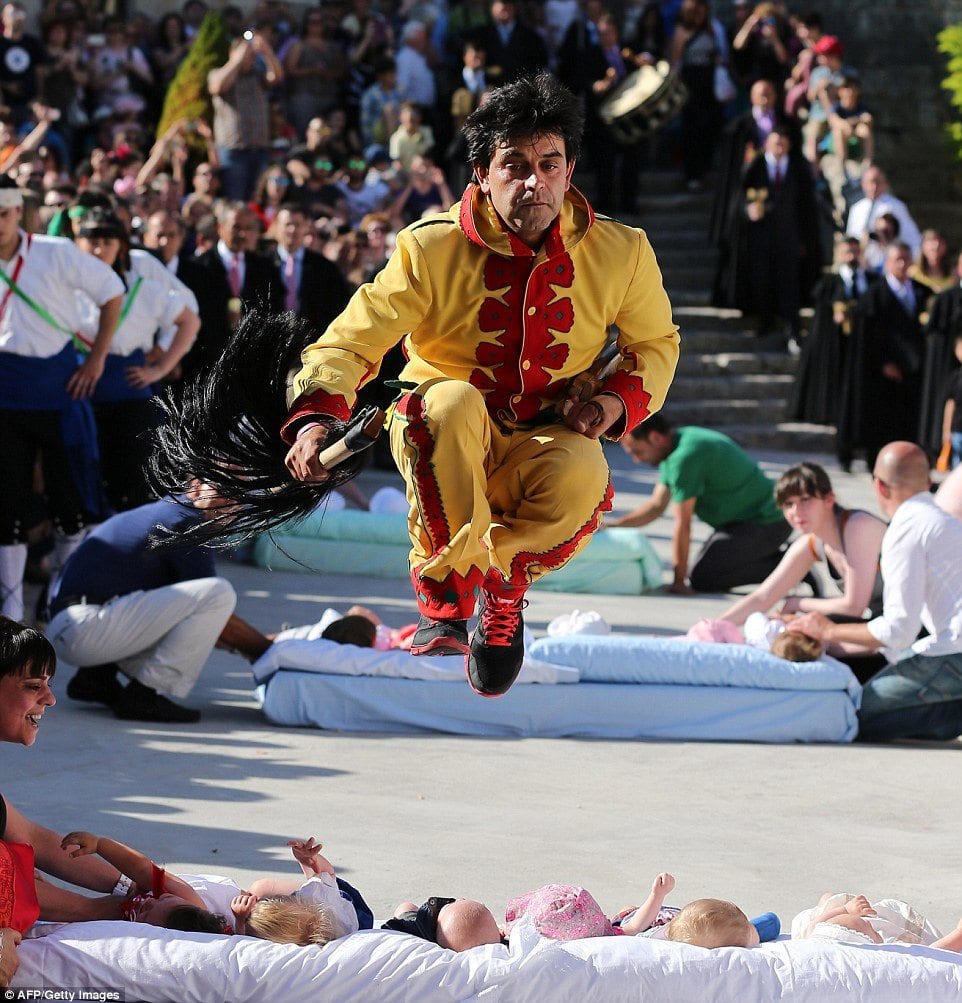
[adinserter block=”7″]
[adinserter block=”2″]
13. Baby Dropping Ritual
Mothers may want to skip this one.
In some parts of India, Muslims and Hindus toss unsuspecting babies 50 ft from balconies onto blankets held by spectators below. In some cases, the crying infants are shaken before being dropped. The practice is believed to bring prosperity and good fortune for the family.
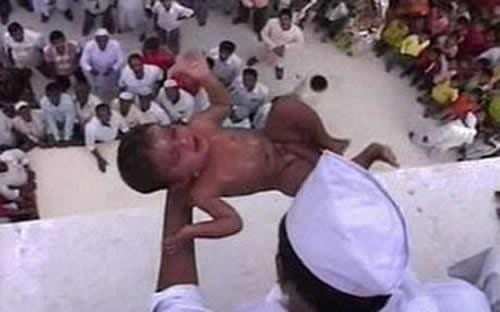
[adinserter block=”3″]
[adinserter block=”8″]
The prevalence of these practices in India is up for the debate, but it’s been going on for about 700 years. It has reportedly been held annually in the state of Karnataka.
The National Commission for Protection of Child Rights banned the ritual in 2011, but it continues to be held in various places including the village of Nagrala.
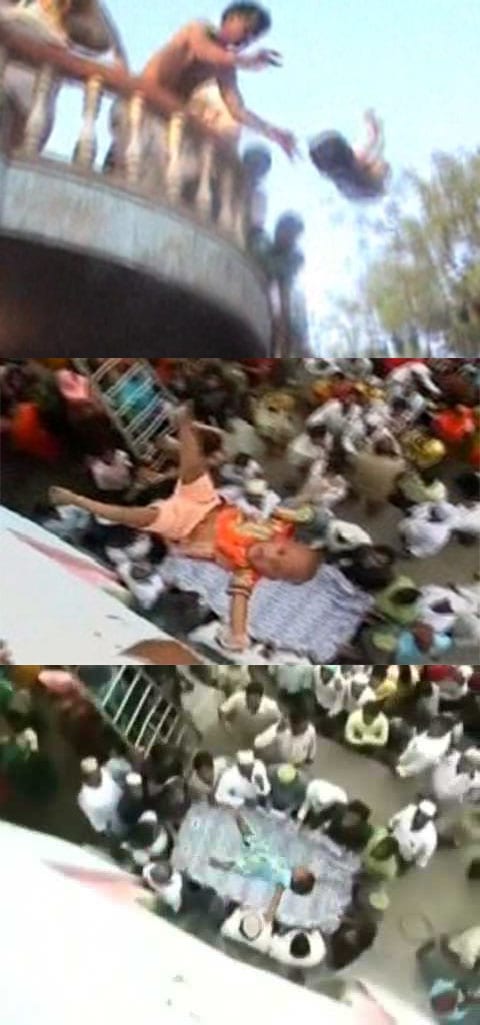
[adinserter block=”7″]
[adinserter block=”2″]
12. Takanakuy (Peruvian Street Fighting Festival)
The holidays aren’t always joyous occasions. Sometimes, people bring beef to the party and nasty shouting matches ensue. People know this in the Peruvian state of Chumbivilcas. That’s why Christmas is specifically dedicated to burying the hatchet with organized fist fights. They call it Takanakuy.
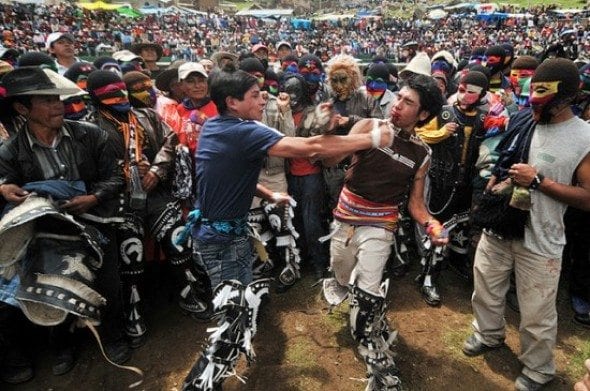
[adinserter block=”3″]
[adinserter block=”8″]
In this Andes mountain community, locals typically hold grudges all year long until December 25th. Then, they can legally settle the score with brawls. Villagers gather to watch men, women, and even children duke it out throughout the town.
The spectacle gives old-school WWF a run for its money. Some brawlers step into the fighting circle wearing ski masks, leather chaps, and even dead animals strapped to their heads. The only things missing are pyro and entrance music.
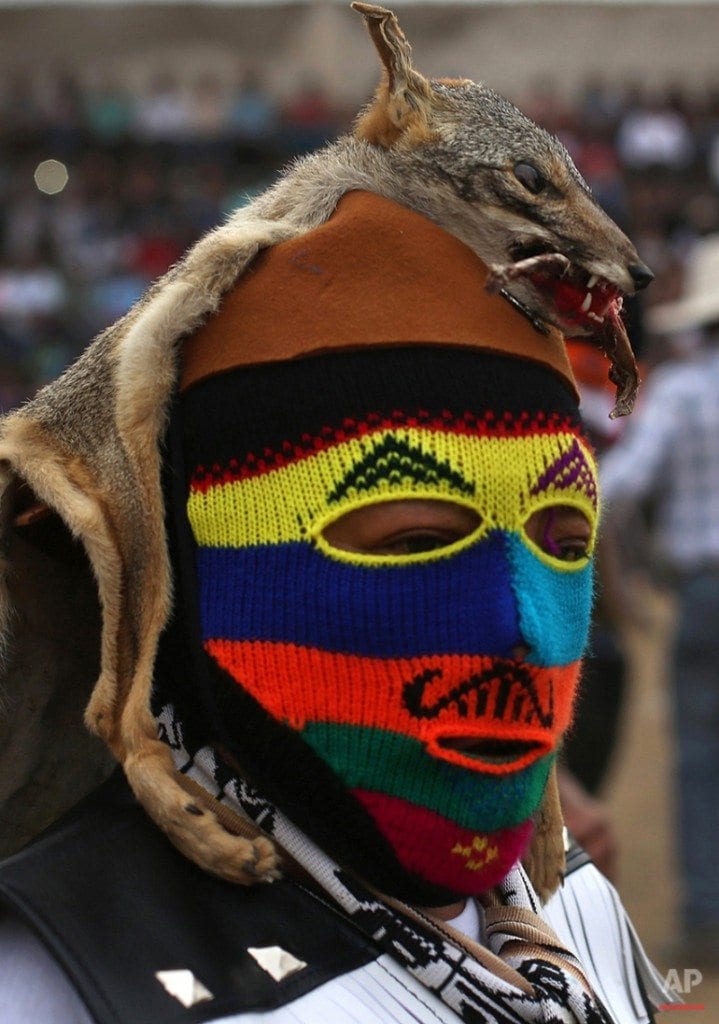
[adinserter block=”7″]
[adinserter block=”2″]
11. The Govardhan Puja Festival
Cows are sacred throughout India. Within the town of Garbada in Gujarat state, there is one day when cows can literally step all over people. On Govardhan Puja, some locals lie on the ground and serve as human rugs for cows to walk on.
It is believed that by offering their bodies to these sacred animals, their prayers would be answered.
Govardhan Puja is held on the fourth day of Diwali or the Hindu festival of lights. The Puja commemorates the lifting of Mount Govardhan by Lord Krishna. Locals use cow dung to create hillocks representing this mountain. They then decorate the cow dung with flowers and offer prayers to Lord Govardhan as they dance around it.
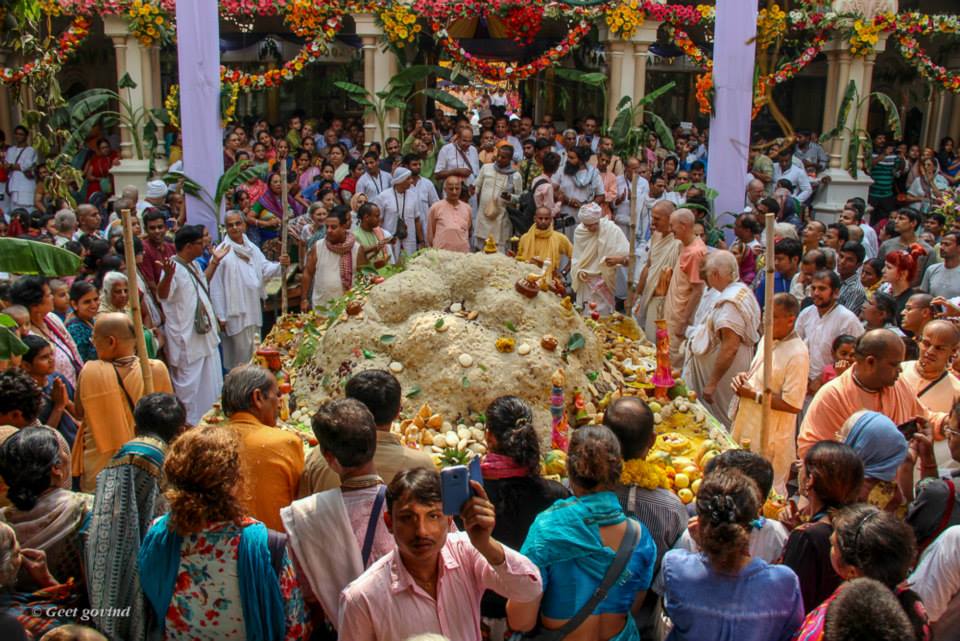
[adinserter block=”3″]
[adinserter block=”8″]
Meanwhile, the cows stomp away with style. Before the ceremony, villagers adorn these animals with colored powder, flowers and henna.
Locals say the ritual has been going on for hundreds of years with no serious injuries to devotees.
Diwali is India’s most important festivity and it’s celebrated across religions. The five days of the festival are marked by family gatherings and celebrations. People light bonfires, ignite clay lamps, and set off fireworks to represent light protecting them from “spiritual darkness.” People also light lamps and leave their doors open to invite Lakshmi, the goddess of wealth.

[adinserter block=”7″]
[adinserter block=”2″]
10. Yanshui Beehive Fireworks Festival
Ever wanted to be in the middle of a wand-wielding firefight like the kind you’ve seen in the Harry Potter movies? It aint Hogwarts, but the Yanshui “Beehive festival” in Taiwan comes close.
On the fourteenth and fifteenth day of Lunar New Year, locals gather by the Wu Miao Temple in the Yanshui district to set off thousands of fireworks.
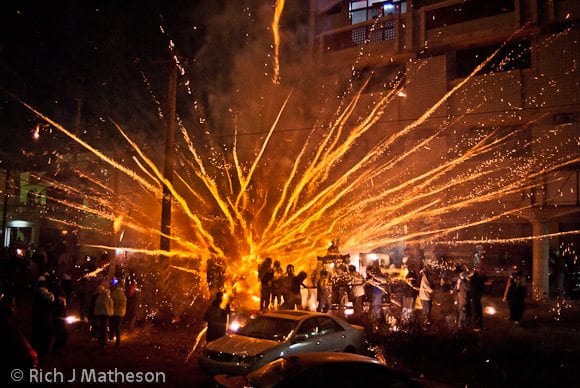
[adinserter block=”3″]
[adinserter block=”8″]
Villagers surround “Beehives,” (or launching pads) loaded with thousands of bottle rockets. Then, they set the hives on fire releasing an onslaught of fiery sparks surging aimlessly throughout the square.
For their protection, people wear whatever they can get a hold of: motorcycle helmets, fire-proof jackets, clothes, you name it. Still, people are burned each year. But, it’s considered lucky to be hit by a spark.
According to local legend, the first festival started in the 1800s, when the city was ravaged by plague and cholera. A local shaman set off fireworks to summon Guan Gong, the Chinese God of War, who vanquished the diseases.
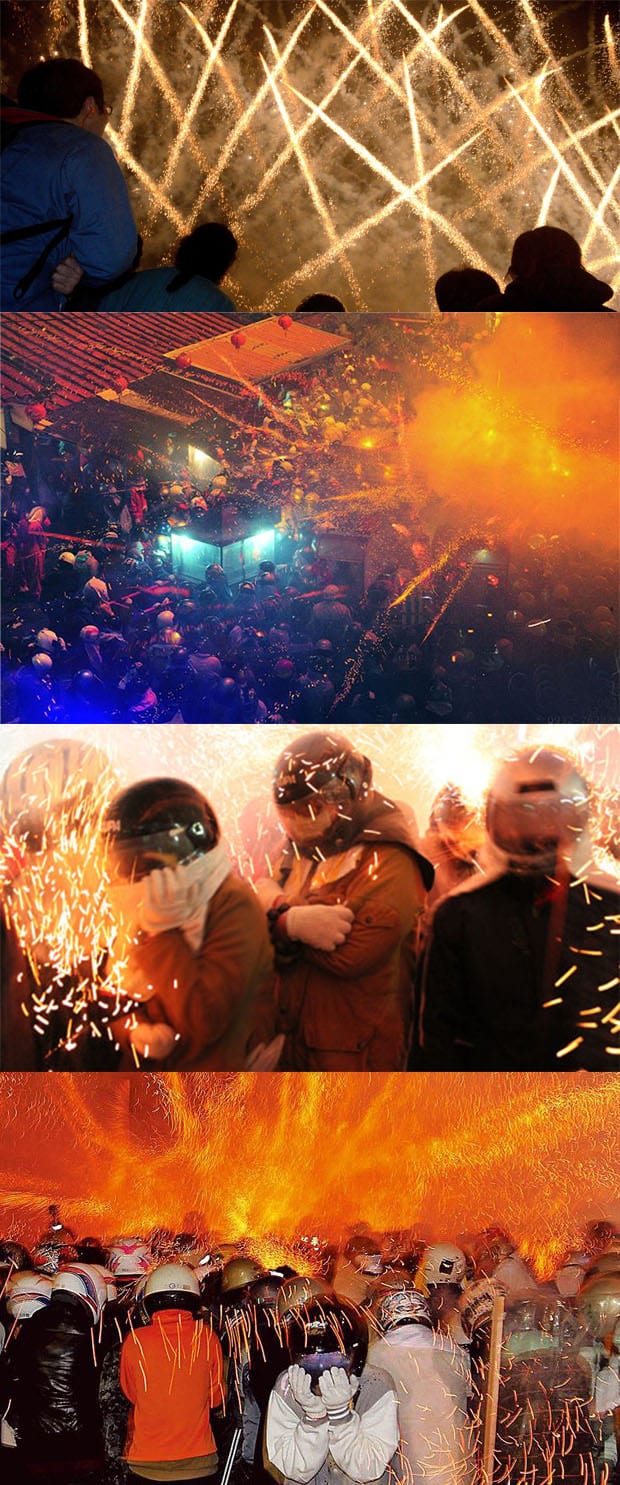
[adinserter block=”7″]
[adinserter block=”2″]
9. Agni Keli Fire Fight
What better way to honor the gods and their fiery wrath than to get set ablaze? That’s the notion behind the Agni Keli celebration in the Indian town of Mangalore.
Every year around April, male devotees armed with torches made from dried coconut fronds gather at a field near the Temple of Durga. The crowd then disperses into two groups facing each other. Finally, it’s time to fire up the night.
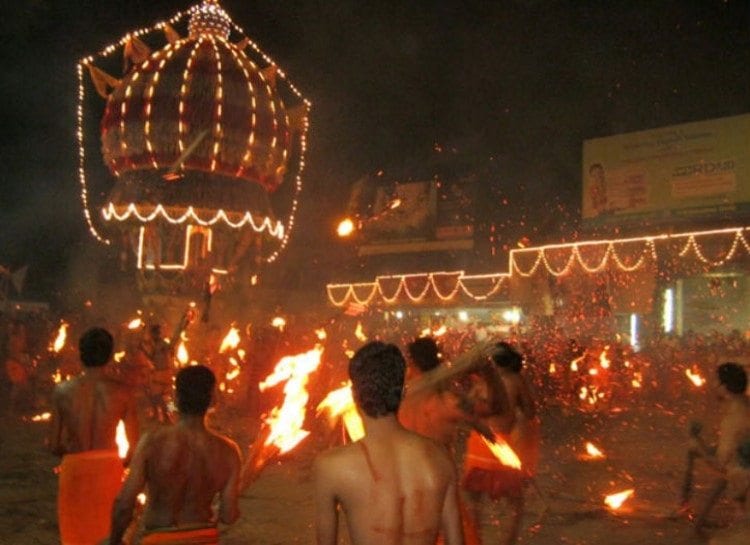
[adinserter block=”3″]
[adinserter block=”8″]
Devotes proceed to hurling the torches at members of the opposing group, creating a scene of hellish chaos in the name of the Hindu goddess Durga.
Each participant is only wearing a piece of cloth covering their privates down to their knees. So, burns and injuries are imminent.
The ritual only lasts 15 minutes, but you can bet your hot ass they make it count.
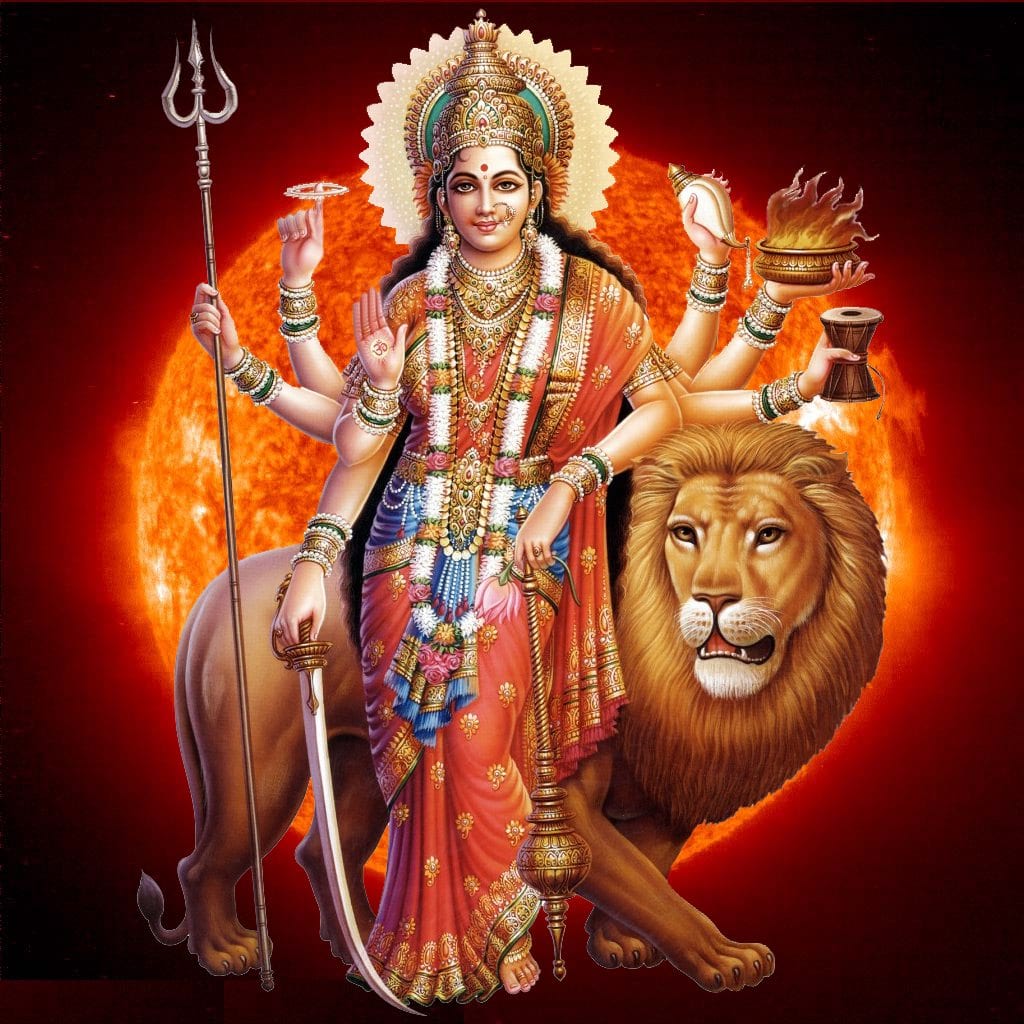
[adinserter block=”7″]
[adinserter block=”2″]
8. Dosojin Matsuri (Japanese Shrine Burning festival)
How do people in the Japanese town of Nozawa Onsen ring in the New Year? They get loaded on sake and nearly set each other on fire.
The Dosojin Matsuri festival kicks off on the morning of January 13. Villagers build a giant shrine while pounding sake. As night falls, bon fires are set and inebriated partiers use them to light torches.
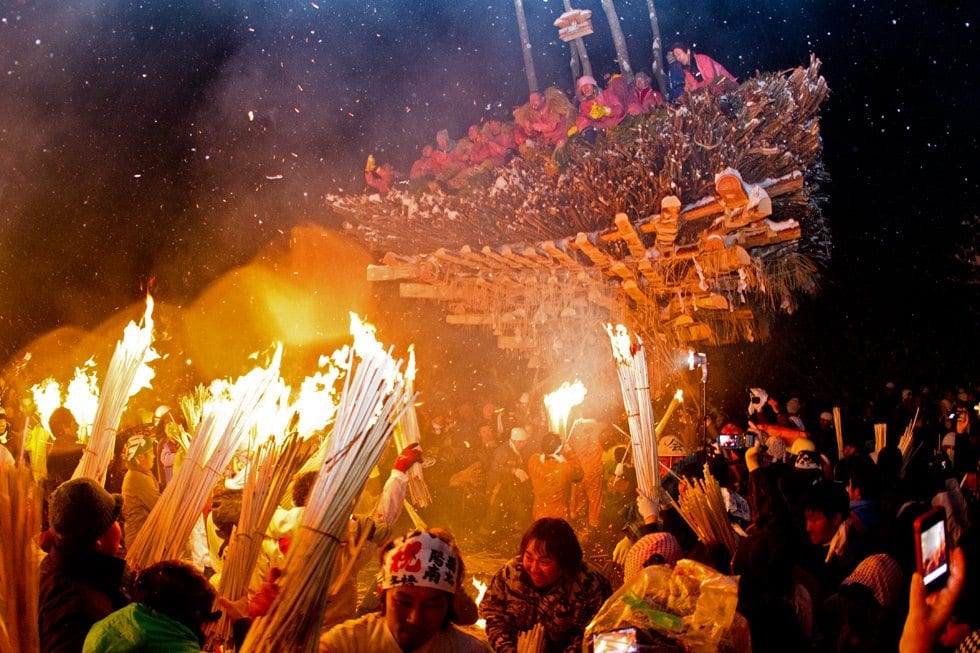
[adinserter block=”3″]
[adinserter block=”8″]
42-year-olds gather on top of the shrine. Down below, 25-year-olds form a protective barrier armed with nothing but pine boughs. Everyone else picks up a torch and charges with full force at the 25-year-olds, as they try to set the shrine on fire. The men push and shove their drunken assailants while desperately trying to swat out fires with pine boughs. Above, the old men heckle the mob and launch kindling.
Hours later, the old men finally call it quits and descend the shrine. Then, everyone gets together and slams some more sake while they watch that mother burn.
Happy New Year!
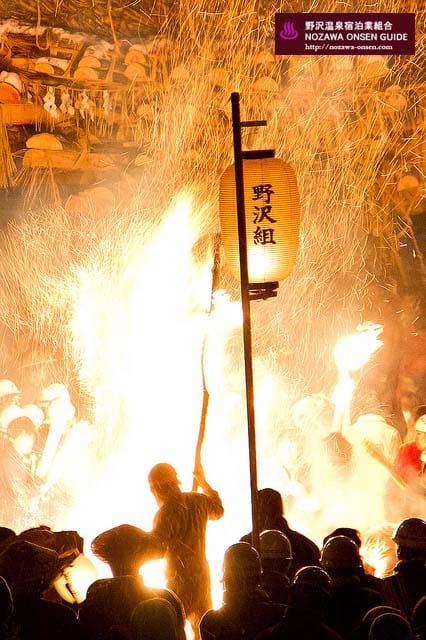
[adinserter block=”7″]
[adinserter block=”2″]
7. The Bani Festival
Who knew worshiping deities could be so extreme. Communities throughout India know all about it. During the Bani festival, they honor the goddess Shiva by coming together and bashing their heads with clubs. And we’re not talking foam bats. They use lathis, the same kind used as batons by police.
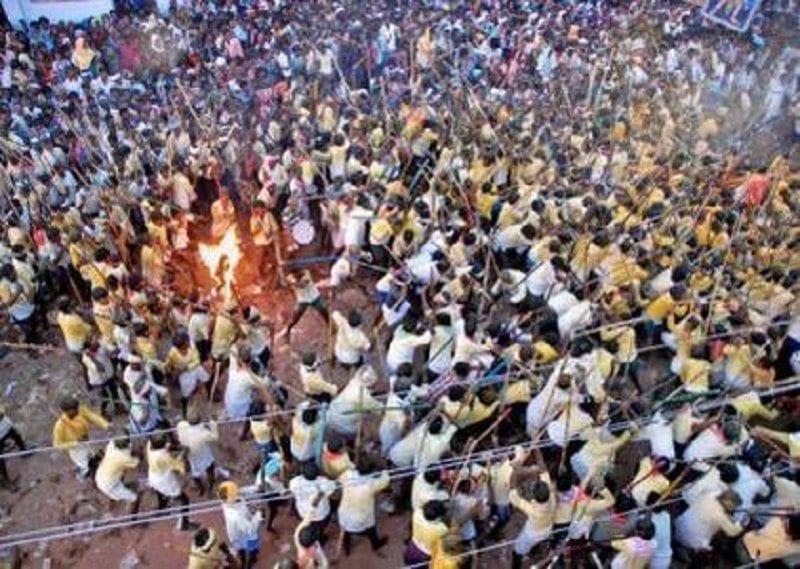
[adinserter block=”3″]
[adinserter block=”8″]
Lathis are bamboo sticks sometimes reinforced with iron. Villagers gather by the Devaragattu Temple in Kurnool, and use them to wack each other repeatedly. It’s done to commemorate the death of a demon at the hands of Shiva.
Covered in blood, some of the most die-hard worshipers keep on rocking to the break of dawn. Dozens of injuries are reported each year.
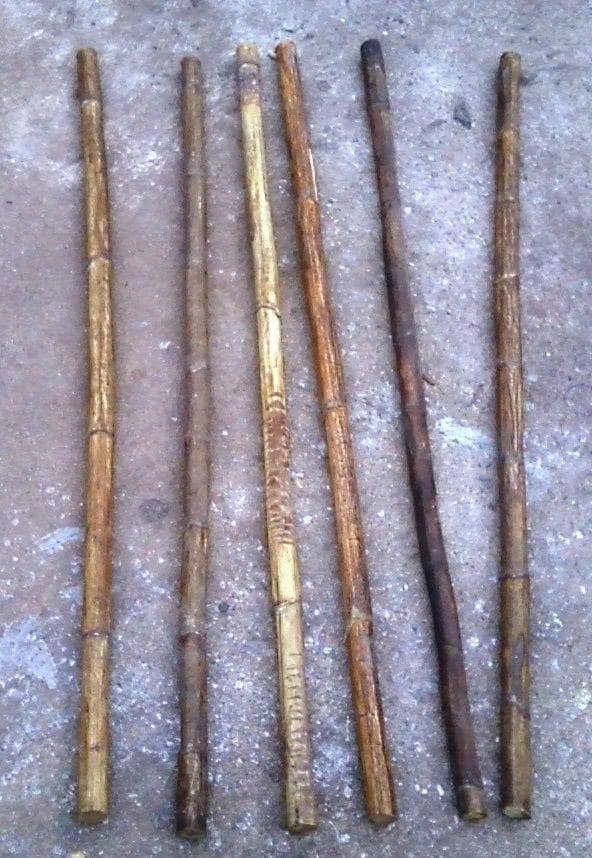
[adinserter block=”7″]
[adinserter block=”2″]
6. Vegetarian Fest
Vegetarians won’t hurt animals. But in the Thai town of Phuket, they’re more than eager to hurt themselves. For the nine days before Nov. 1, locals honor the Nine Emperor Gods by abstaining from meat. Instead, they indulge in self-mortification.
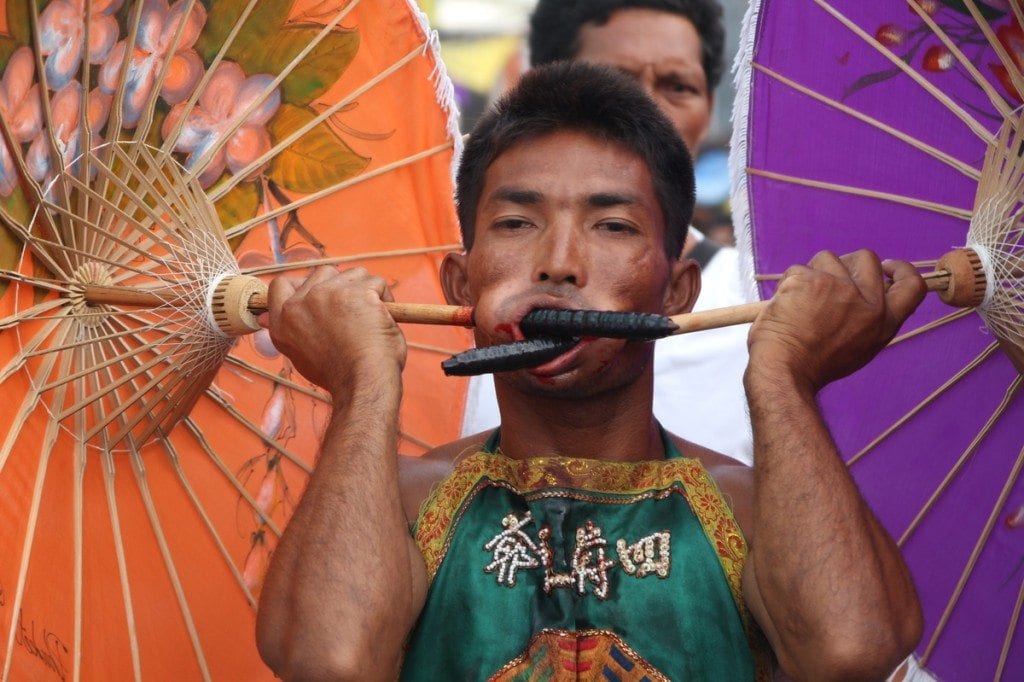
[adinserter block=”3″]
[adinserter block=”8″]
People impale their cheeks with knives, skewers, umbrella poles and any sharp objects they can find.
Legend has it that the first vegetarian festival started two centuries ago when a group of traveling Chinese opera singers fell ill with malaria. They decided to stick to a vegetarian diet and prey to the nine gods. To everyone’s surprise, they survived this disease that killed scores in the 1800s.
Now, locals sacrifice their bodies in the vicinities of Chinese shrines throughout the island each year. They believe their offerings will bring about good health. Many report feeling no pain. However, dozens are injured each year and one person died in 2011.
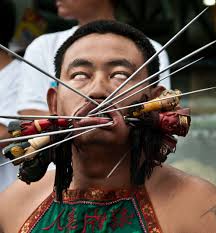
[adinserter block=”7″]
[adinserter block=”2″]
5. Thaipusam (Body-piercing Festival)
Some people pay tribute to their deities by praying before alters, making symbolic tributes, or fasting. But when you’re the god of war, that just won’t cut it. Throughout India and Southeast Asia, devotees of Lord Murugan honor him by putting themselves through hell.
Believers drive spears through their cheeks, needles through their tongues, and hooks throughout their bodies.
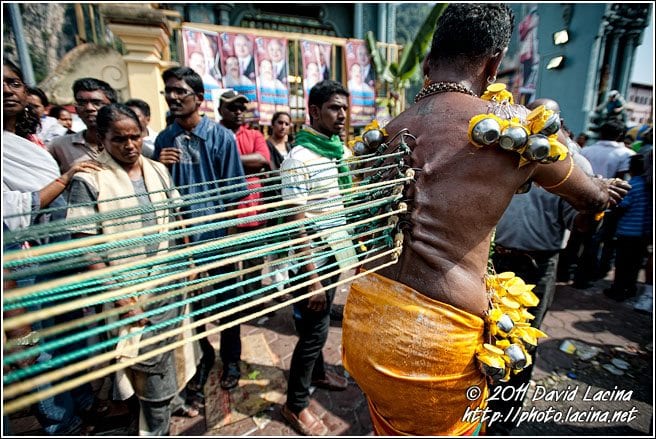
[adinserter block=”3″]
[adinserter block=”8″]
In parts of Malaysia, these hooks are attached to chains that fasten an extravagant alter weighing up to 66 pounds above their heads. The scene may resemble something out of the movie Hellraiser. But, devotees say they feel no pain.
Instead, they say they’re taken into a trance like-state as they parade through the streets to cheering crowds and the sounds of drums. Sometimes, hooks on their backs are attached to carts or tractors which they then pull through the processions.
Even while impaled, they perform the kavadi dance often with big smiles across their faces. Women and children are also happy to take part in the offerings.
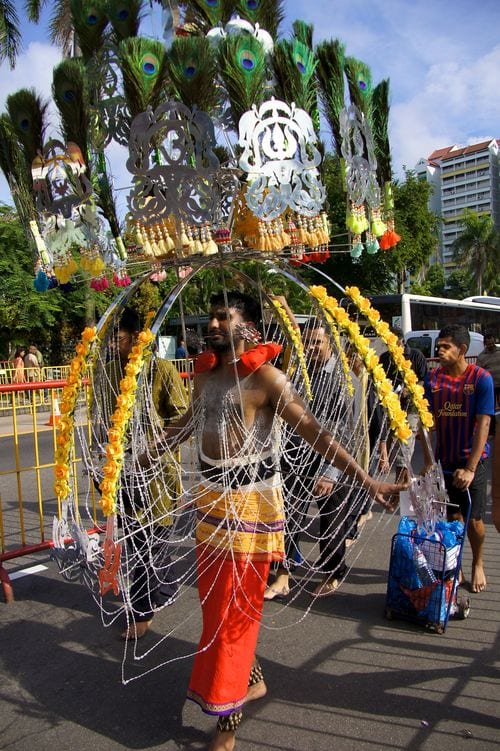
[adinserter block=”7″]
[adinserter block=”2″]
4. Suwa Onbashira (Japanese Log-Riding Festival)
This next one sounds like it comes out of a 12-year-old’s dream. But it’s very real and very dangerous. Every six years, residents from Japan’s Lake Suwa area cut down massive trees, and ride the logs down super-steep mountains. The festival represents the spiritual renewal of four shrines in the region.
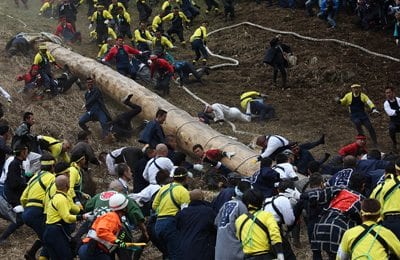
[adinserter block=”3″]
[adinserter block=”8″]
As big as these 15-meter logs are, sometimes you still need room. So, villagers attach ladder-like structures on the log to occupy more raging hooligans.
After they clear the slopes, participants carry the logs through a lake toward the shrines. Finally, they raise the logs by the four shrines using ropes. To add to the show, some party animals climb the logs as they’re erected. Each ritual sees hundreds of injuries. Some have also died.
In Suwa, such a fatality is considered an honorable death.
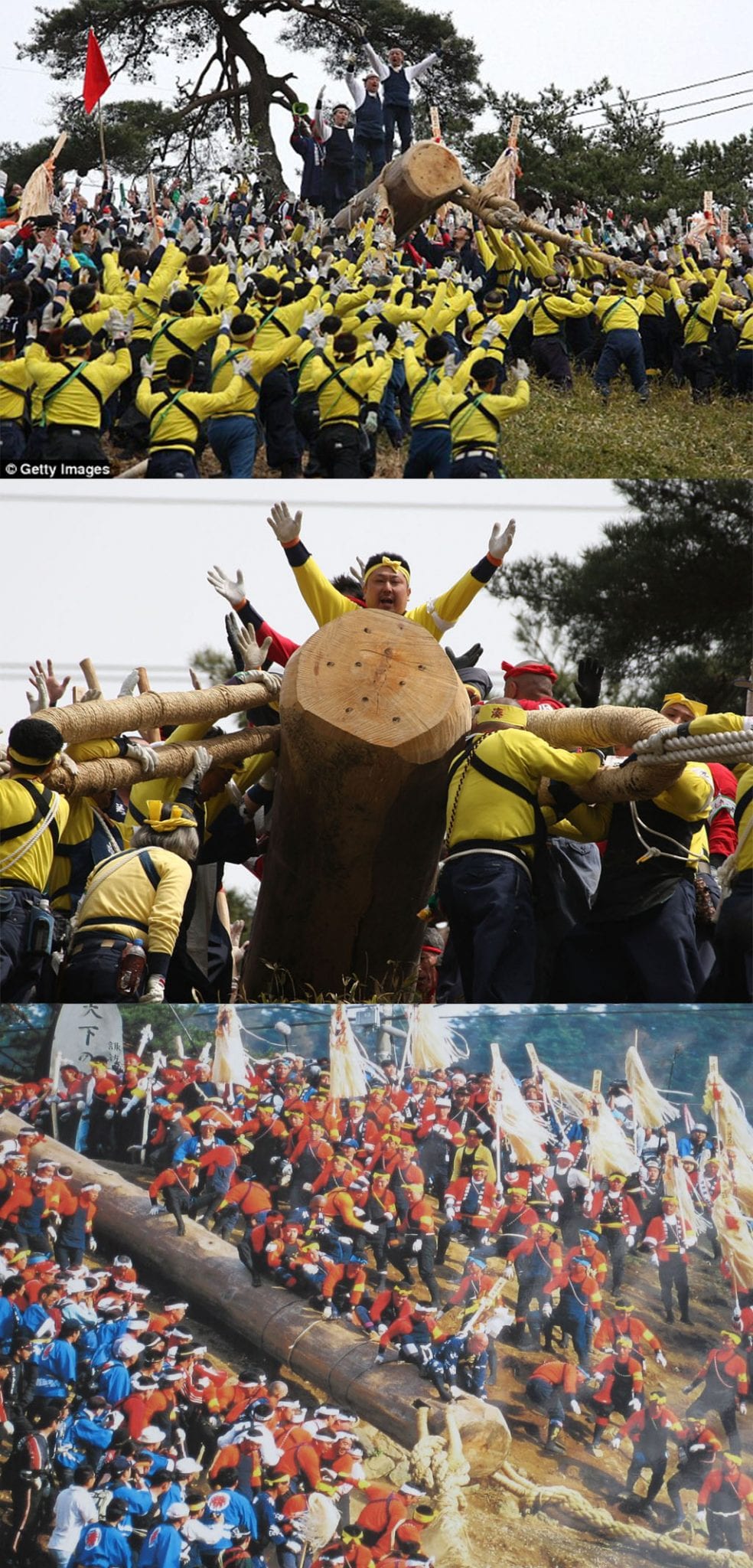
[adinserter block=”7″]
[adinserter block=”2″]
3. Gotmar Rock-Throwing Festival
Every year, villagers in the Indian state of Madhya Pradesh come together to celebrate a bloody, but cherished past time: The rock-throwing battle. On one side there’s the Saargaon team. On the other is the crew from Pandhurhna. Between them is a no-man’s land where massive stones rain indiscriminately.
Armed with rocks, these players must cross a war zone and capture a tree in the middle of the river that separates the two villages. Warriors drag away the bloodied bodies of their unconscious comrades, as their brothers advance toward victory.
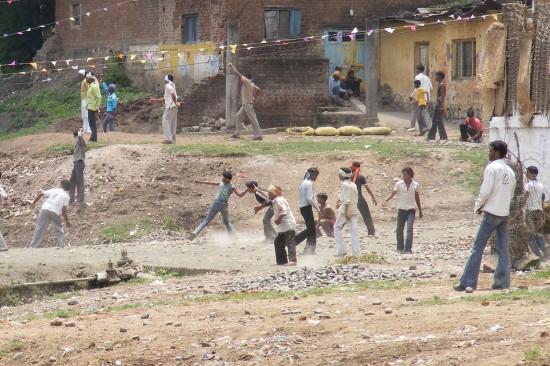
[adinserter block=”3″]
[adinserter block=”8″]
Every year, hundreds are injured and a few even die. But don’t expect the festival to go away anytime soon. When police tried to enforce a ban that went into effect in 2009, villagers rioted and threw rocks at them. The battle still goes on.
Despite the bloodshed, this sport is rooted in love. Sort of.
Legend has it that hundreds of years ago, two lovers crossed the river to elope with each other against their families’ wishes. As they crossed, villagers from both sides launched rocks killing both lovers.
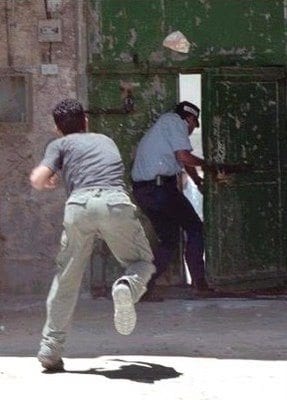
[adinserter block=”7″]
[adinserter block=”2″]
2. Jallikattu Bull Fight
So, you’ve been running with the bulls? Big deal!
Throughout the Indian state of Tamil Nadu, bulls run from people. As part of Pongal celebrations, hundreds of men chase these beasts and hold onto them in order to win prizes tied to their horns. In some cases they have to hold on to their humps for 15 to 20 meters for victory.
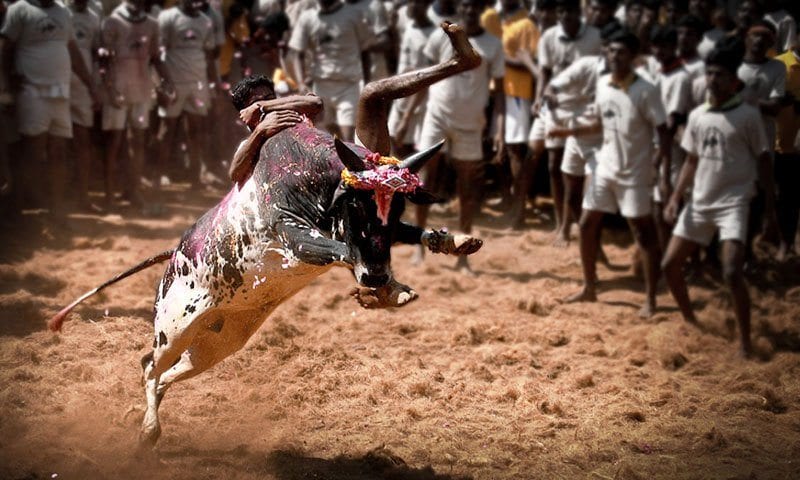
[adinserter block=”3″]
[adinserter block=”8″]
The jallikattu bulls are trained and fed to become as fierce as possible. In the last 20 years, more than 200 people have died after being gored or trampled. Hundreds more have been injured. In May 2014, the Supreme Court of India banned the sport. Not because of the death toll, but because the court deemed it was cruel to animals. Unlike their counterparts in Spain, however, the jallikattu bull is not killed after these events.
As of February 2016, hearings are being held over a government order to lift the ban.
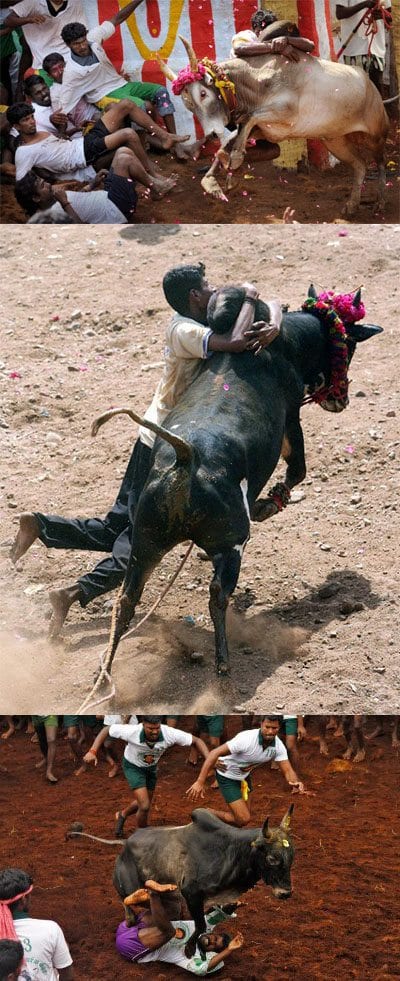
[adinserter block=”7″]
[adinserter block=”2″]
1. Exploding Sledgehammer Fest
Legend has it that hundreds of years ago, San Juan Bautista helped a local rancher and devoted catholic Juan Aquino retrieve his stolen gold from bandits. Now, every February the San Juan de La Vega villagers celebrate Juan Bautista’s triumph by strapping explosives to sledgehammers! Some people celebrate their town’s namesake with ceremonies and feasts, but when your village is named after a badass like San Juan de La Vega, it is custom to blow shit up and run from falling sledgehammers!

[adinserter block=”3″]
[adinserter block=”8″]
When February finally rolls around, villagers celebrate their patron saint’s explosive triumph over the thieves by strapping explosives to sledgehammers, and driving those bad boys down a steel railing in the middle of a soccer field. (Or “futbol” for those of you outside the U.S.)
Crowds descend on the field. They break up into two sides, one representing the bandits and the other representing Aquino. They then take turns slamming the loaded hammers. Every hit creates a cloud of phosphorous smoke and sometimes sends shrapnel flying aimlessly throughout the field.
In the past, people have lost their eyes, a boy lost his hand, and a teen burned nearly 90 percent of his body after his explosive-laden backpack exploded due to a nearby blast. At least 25 people were injured with shrapnel wounds in 2015. Nonetheless, the fiesta has been raging for centuries.
Why stop now?
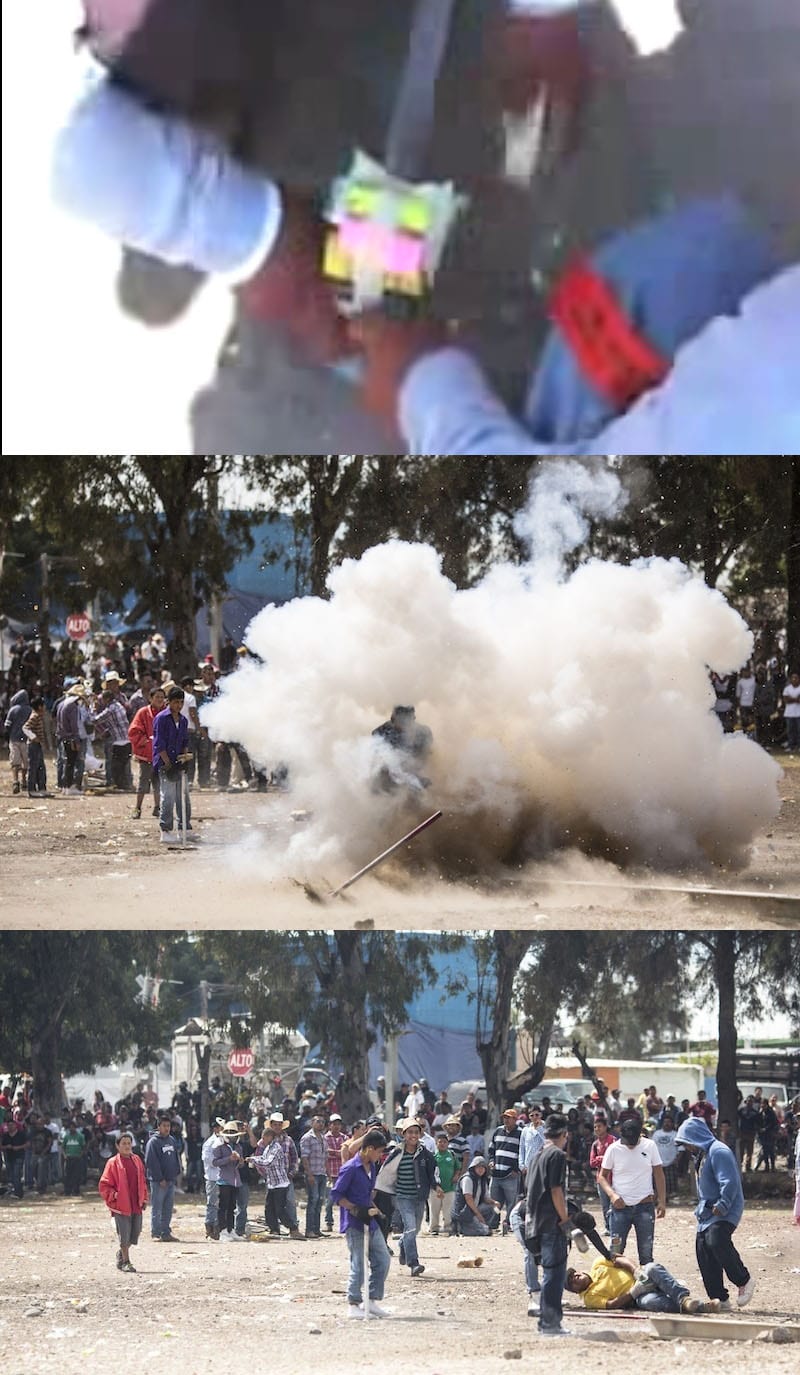
[adinserter block=”7″]
[adinserter block=”2″]